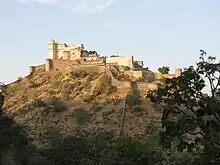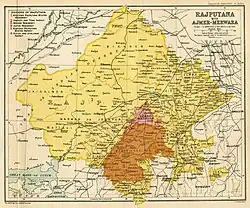| Shahbaz Khan's Invasion of Mewar | |||||||||
|---|---|---|---|---|---|---|---|---|---|
| Part of Mughal conquest of Mewar | |||||||||
 Territories including Chittorgarh, Udaipur, Gogunda, Kumbhalgarh and Central Mewar annexed to Mughal empire. | |||||||||
| |||||||||
| Belligerents | |||||||||
|
| |||||||||
| Commanders and leaders | |||||||||
|
|
| ||||||||
Shahbaz Khan's invasions of Mewar were the ongoing expeditions into Mewar by the Mughal forces of Shahbaz Khan Kamboh. The expansion of the Mughal Empire was initiated during the reign of Akbar the Great. This was notably evident in the Battle of Haldighati, where the Mewar forces suffered a futile defeat, compelling Rana Pratap to retreat to the hills. In the aftermath, multiple expeditions were dispatched to Mewar under the leadership of Shahbaz Khan Kamboh, ultimately leading to the permanent pacification of important territories like Mandalgarh, Kumbhalgarh, Gogunda, and Chittorgarh. These successful conquests culminated in the assimilation of Mewar into the Mughal Empire in 1615.
Background


Following the defeat at the Battle of Haldighati, Maharana Pratap made several unsuccessful attempts to achieve independence for Mewar from Mughal rule.[1][2] Despite a temporary re-invasion of Gogunda after Man Singh's recall to the emperor, Pratap Singh invaded Gogunda. But was ultimately unsuccessful as Man Singh, dispatched by the Emperor, achieved victory, prompting Rana's retreat to the hills.[3][1] Upon learning of Rana's bold actions, the Emperor dispatched Bhagwant Das, Man Singh (who had returned to the Emperor), Mir Bahar, and others to reclaim the territories lost by Maharana Pratap.[4]Subsequently, when the imperial army arrived, the Rana retreated to his mountainous hideouts, resulting in the recapture of these outposts by the Mughal officers around July of 1577 A.D.[4]
Sources
Contemporary sources from Abul Fazl depict how Shahbaz Khan Kamboh recurrently compelled Pratap Singh to withdraw to his mountain stronghold of Chavand. Mewar, an integral part of Rajputana, faced multiple invasions from neighboring kingdoms. During Pratap Singh's reign, Mewar endured significant hardships under the rule of the Mughal Empire, leading to a depletion of resources.[5] Mughal officer Man Singh Kachwaha spearheaded several invasions into Mewar, eventually incorporating Central Mewar into the Mughal empire.[4] Consequently, Rana retreated to his mountain hideouts, resulting in the fall of these outposts into the hands of Mughal officers around July 1577 A.D.[4][3]
Battles
Multiple invasions led by Shahbaz Khan Kamboh resulted in the decline of Pratap Singh's power and the economic resources of Mewar. These Mughal invasions weakened Mewar's foreign relations with neighboring kingdoms.[5][4]
Some of the invasions conducted under the command of Shahbaz Khan Kamboh include:
Recapture of Gogunda
In 1577 A.D., When the imperial army arrived, the Rana Pratap retreated to his mountain hideouts, resulting in the fall of these outposts into the hands of the Mughal officers around July 1577 A.D.[4][3]
Capture of Kumbhalgarh 1578A.D.

In 1578 A.D., the Mughals successfully gained control of Kumbhalgarh Fort after a fierce battle on April 3rd, 1578 A.D.[4][3]
Capture of Mandalgarh
In 1578 A.D., the Mughal emperor appointed Shahbaz Khan Kamboh in December with the objective to punish the Rana for his daring activities. The Mughal commander successfully achieved his goal by forcing the Rana to retreat to his hilly fortress and then returned.[4][3]
Capture of Central Mewar 1579A.D.

In 1579, once again in November, the Mughal forces came to Mewar with the aim of subduing Pratap. This time, they stayed in Mewar until around the middle of 1580 and oversaw Mughal operations against Pratap. As a result, the Rana's influence was eradicated from the central region of his territory, and he was compelled to retreat to his hilly strongholds.[4][3]
Battle of Sherpura

In 1580, during the Battle of Sherpura, Abdur Rahim Khan Khanan was appointed as the governor of Ajmer and the commander responsible for leading the Mewar campaign. Khan Khanan conducted an expedition against the Maharana Pratap, leaving his family behind at Sherpura. The Maharana Pratap retreated to his hilly stronghold of Dholan as the Mughal forces advanced to capture him. Meanwhile, Kunwar Amar Singh made audacious efforts to invade Sherpura, diverting the attention of the Mughal general and successfully capturing the Mirza's family. Upon learning of the captivity of the ladies, the Rana Pratap instructed his son to return them with all due respect to the Mirza's location.[4][3]
Aftermath
The Mughals achieved control over Central Mewar, integrating much of the region, both directly and indirectly, into their empire. The territories of Mewar that came under the rule of the Mughals included Kumbhalgarh, Mandalgarh, Chittorgarh, Gogunda, and Central Mewar, along with Udaipur.[4][3]
See also
References
- 1 2 Majumdar R.c. (1974). The Mughul Empire. pp. 131–132.
- ↑ Medieval India Satish Chandra. pp. 151–155.
- 1 2 3 4 5 6 7 8 Srivastava, lal Ashirbadi (1957). Akbar The Great Vol 1. pp. 197–220.
- 1 2 3 4 5 6 7 8 9 10 11 Sharma, G. N. (1954). Mewar and the mughal emperors. pp. 82–121.
- 1 2 Mankekar, d r (1976). Mewar Saga. pp. 60–69.